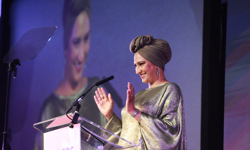Girl Talk’s 500th issue hit the shelves last month, making it the longest running magazine for tween girls on the newsstand today. Since 1995, we’ve been their guide to life, their big sister or a trustworthy friend.
Pulling issue No 1 out of the archives made us laugh; it looks incredibly retro and sweetly naive. And putting issue 1 and 500 side by side shows not just how much girls have changed in the last 19 years, but also how much tougher kids’ magazine publishing has become.
I was stunned at how easy the editor of that first issue of Girl Talk had it! Just a few simple coverlines, no big sells, no ‘package’ featuring multiple gifts in a flashy polybag. The main image on that first issue is just a smiling little girl and the covermount is a “fabulous choker”. There are no celebrities, just ponies and puppies, no big promises, no fluro colours. Whereas our 500th issue comes with 370 nail stickers (seriously), two nail polishes, a Drumstick bar, 100 Free Swapit points for every reader, WIN a £500 shopping spree and five One Direction posters to collect. That’s value!
The package we now offer the reader in order to compete is just a reflection of the market and the fight for their attention. This isn’t just competition at the newsstand, but all the other new places to spend pocket money – online, on a phone, in Primark, in Claire’s. When Girl Talk launched, we were the only magazine in this age range for girls and there wasn’t even a fraction of the media or products aimed at 10 year olds. No children had mobile phones, some had games consoles, no one had the internet, and social media didn’t exist.
So how did we get from a fabulous choker to 370 nail stickers? The evolution of Girl Talk has happened in three stages, as I see them.
Phase one: That’s what we refer to now as our ‘wholesome era’. At this point, we were part of BBC Worldwide, we had the BBC logo on the front cover and our editorial had a kind of Reithian flavour. In that phase there weren’t many celebrities in the magazine and barely any fashion; two strong editorial pillars nowadays. We printed sheet music to play Whigfield’s Saturday Night on the recorder and showed how to make a money box out of a margarine tub. It was a very innocent and very sweet magazine.
Phase two: This coincided with the High School Musical explosion around 2006. Our readers were suddenly all celeb-worshippers with dangerous Disney Channel obsessions. This was when we made the big decision to replace the smiling cover girl with a celebrity face. It was a move that changed the landscape of pre-teen magazines. Women’s glossies were going that way, so we followed. Unknown faces would never sell the same amount as a celebrity and there’s no going back. Despite the paradigm shift, we still held on to our ethical principles. We’ve always tried to stop girls growing up too quickly; protecting readers from sex and boys is vital. Positivity and zero-tolerance on criticising other girls is fundamental. We never made snide remarks about celebs, or pointed out their physical flaws.
Phase three: This is what I would like to call the feminist era. Phase two persisted, celebrities – and crucially, a very narrow range of celebrities – dominated our pages. We were giving our readers the stars they loved, while doing our bit to safeguard them, but then, something happened. A kind of creeping disease in popular culture. It was the hyper-sexualisation of pop and TV stars, and advertising in general. It’s not easy to carbon-date the start, but it’s clear from a quick flick through our back issues that mainstream celebs in 2004 were, on the whole, just much more innocent than they are in 2014.
Back then, we were wary of putting the Sugababes into Girl Talk. We thought they were just a bit too raunchy, what with their low-slung jeans and piercings. But we didn’t know what was about to hit us, like a big, swinging wrecking ball. We didn’t know that, soon, Miley Cyrus would be naked in that infamous pop video. And now, sadly, most of our readers’ favourite stars are very sexual – because this kind of objectification is everywhere.
Search for positive role models
As this problem with sexualisation grew, news stories about bad female role models and girls’ lack of ambition kept churning out. Surveys from Ofsted and the Girl Guides told us that girls’ main worry was their bodies, and they believed women were judged more on their looks than ability. The American Psychological Association linked the media’s increasingly sexualised output to common mental health problems in girls – eating disorders, low self-esteem and depression. On the Girl Talk team, we had to ask ourselves: how much are we part of the problem?
Everyone kept talking about the effect of the media, well, we are the media. We had to consider what we were doing.
We ran a survey to find out more about our readers’ lives, role models and aspirations. The replies showed that the women they admired most were pop and TV stars. Sportswomen, writers and politicians barely made the list.
We asked our readers how they would like to be described and the top answers were ‘pretty’, ‘kind’ and ‘funny’, rather than the other options of ‘strong’, ‘brave’ and ‘clever’.
Sadly, I wasn’t really surprised by the results; what else could we expect our readers to say? When did we last feature anyone outside of mainstream celebsville? When had we ever run a “how brave and strong are you?” personality quiz? Never.
We realised that we had to do something to be part of a solution, not the problem. We had to show our readers some different women to look up to, inspire them to have confidence and encourage interests in areas that aren't traditionally ‘girly’.
The Girl Talk promise
Introducing feminist ideas into a pre-teen magazine whilst maintaining commercial viability is complicated. We’re making small steps. Rather than taking out the features our readers like, we’re adding in new ideas and celebrities. We've recently run profiles on racing driver Susie Wolff and activist Malala Yousafzai. And in every issue, we print our Girl Talk promise:
* I will love myself the way I am
* By working hard I know I can achieve great things
* I will accept others for who they are
* I will have confidence to stand up for my friends and other girls
* I believe girls are equal to boys
To readers, the magazine won’t look dramatically different, but hopefully they will notice a new variety of women on our pages, as well as serious pieces to read and a sense that being pretty and famous isn't everything. I'm proud of the changes we've made – they might seem small, but in this industry it means something. And it seems to mean something to parents too.
The reaction to the campaign has been overwhelmingly positive so far. It sounds like parents have long been frustrated about the effect of the media on their daughters, but felt powerless to do anything. It should be clear that we aren't turning the magazine into a radical feminist manifesto; we’re just trying to offer more to girls. I'm happy we've struck on something that people really care about. One father wrote to me: “Kudos on your stance. My daughters salute you”, which is nice.
Right now, we feel proud of taking a position and trying to make a change for good. We’re doing something that makes our brand really mean something. Something positive that readers might remember at the newsstand and when they grow up. We shouldn’t underestimate how much they want to know about inspiring women that don’t necessarily conform to one ideal. I wonder if perhaps we haven’t quite given them enough credit for that until now.
And where to next? The market has changed and it’s volatile. We need to always be doing more and giving more. Pre-teen print magazines may have longevity because of the free gift; a tangible reason to buy. And we can survive a while if we really use the medium, as with our sister magazine Girl Talk Art. This title has stayed steady since its launch and bucked downwards trends possibly because it involves cutting out pages, using the free gift to make projects and really exploiting the physicality of the product.
Girl Talk has ventured into video now and that’s important too. We have to be across all platforms now. Being a ‘medium neutral brand’ would be the aim; with equally valid editorial across online, apps, video and magazine. The only way to do that is to have a brand that clearly stands for something and has a true USP. Our ‘Girls Are Amazing’ ethos gives us just that and our audience knows that we are the entertainment brand truly looking out for pre-teen girls.












